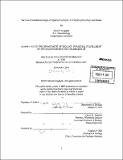| dc.contributor.advisor | David M. Sabatini. | en_US |
| dc.contributor.author | Sengupta, Shomit | en_US |
| dc.contributor.other | Massachusetts Institute of Technology. Dept. of Biology. | en_US |
| dc.date.accessioned | 2010-08-30T14:28:42Z | |
| dc.date.available | 2010-08-30T14:28:42Z | |
| dc.date.copyright | 2010 | en_US |
| dc.date.issued | 2010 | en_US |
| dc.identifier.uri | http://hdl.handle.net/1721.1/57673 | |
| dc.description | Thesis (Ph. D.)--Massachusetts Institute of Technology, Dept. of Biology, 2010. | en_US |
| dc.description | Cataloged from PDF version of thesis. | en_US |
| dc.description | Includes bibliographical references. | en_US |
| dc.description.abstract | The multi-component kinase mTOR complex 1 (mTORC 1) coordinates nutrient and growth factor inputs with numerous downstream processes including protein translation, autophagy, metabolism and cell growth. We have found that inhibition of mTORC 1 with rapamycin treatment suppressed whole-body postnatal growth similar to reduced caloric intake. We found that while feeding activated mTORC 1 in almost every tissue, there was variability in the upstream activating stimuli. The role of mTORCl in organ growth was further elucidated by studies we performed using liver-specific mTORC1 gain and loss of function mutants. Confirming our studies with rapamycin, genetic activation or suppression of mTORC 1 increased and decreased liver size respectively, and rendered the liver insensitive to nutrients. Rendering the liver insensitive to nutrients also had functional consequences. In response to starvation, the liver shifts to fatty acid catabolism and generates ketone bodies to supplement lowered glucose levels. We find that constitutive activation of mTORC1 prevents the liver from initiating fatty-acid oxidation and ketone production in response to fasting. Many aspects of the hepatic fasting response malfunction in old age including fatty acid catabolism and ketogenesis. We find this aging-dependent process is mediated by mTORC 1, and thus loss of mTORC 1 function throughout the adult life of the animal prevents the aging induced decrease in hepatic ketogenesis. As such, pharmaceutical inhibition of mTORC 1 may be beneficial in battling metabolic disorders due to aging. | en_US |
| dc.description.abstract | (cont.) Pharmaceutical inhibition of mTORC is a potential treatment for patients suffering from tuberous sclerosis complex (TSC). The disease TSC in humans is initiated by loss of TSC1 or TSC2, which results in hyperactive mTORC 1 activity. The disease can involve development of multiple lesions including brain harmatomas, angiomyolipomas (AMLs), and lymphangioleiomyomatosis (LAM). We have engineered transgenic mice that express Rheb2, an mTORC 1 activator, in a doxycycline-inducible manner. Overexpression of Rheb2 led to cystic growths with characteristics of both LAM and AML. We hope this mouse model will be helpful in furthering our understanding of the pathology behind these lesions, and provide a mouse model for therapeutic intervention for TSC. | en_US |
| dc.description.statementofresponsibility | by Shomit Sengupta. | en_US |
| dc.format.extent | 154 p. | en_US |
| dc.language.iso | eng | en_US |
| dc.publisher | Massachusetts Institute of Technology | en_US |
| dc.rights | M.I.T. theses are protected by
copyright. They may be viewed from this source for any purpose, but
reproduction or distribution in any format is prohibited without written
permission. See provided URL for inquiries about permission. | en_US |
| dc.rights.uri | http://dspace.mit.edu/handle/1721.1/7582 | en_US |
| dc.subject | Biology. | en_US |
| dc.title | The role of mammalian target of rapamycin complex 1 in hepatic physiology and disease | en_US |
| dc.type | Thesis | en_US |
| dc.description.degree | Ph.D. | en_US |
| dc.contributor.department | Massachusetts Institute of Technology. Department of Biology | |
| dc.identifier.oclc | 615594914 | en_US |
